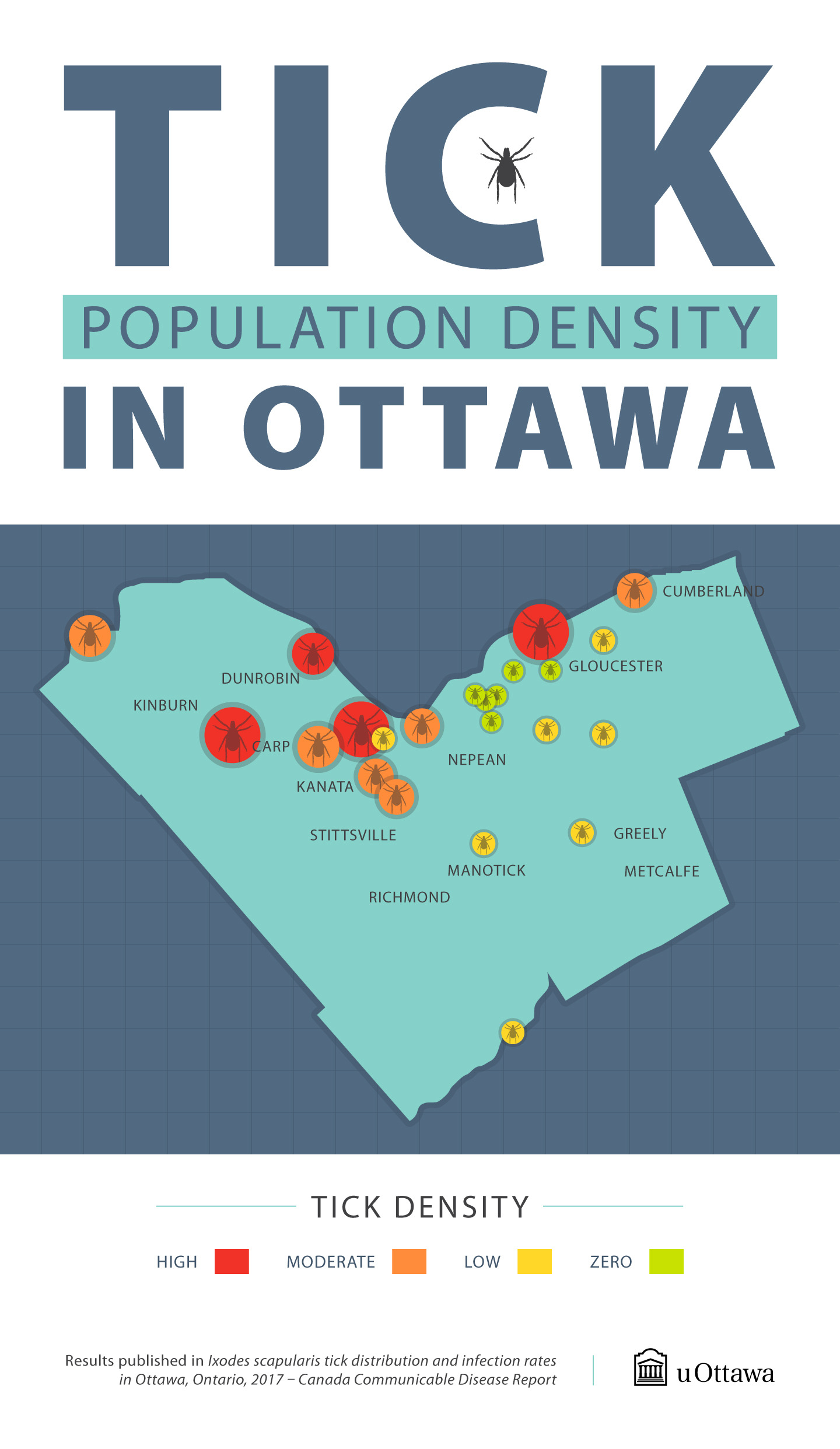Dressed in hazmat suits, researchers at the University of Ottawa Faculty of Medicine Manisha Kulkarni and Roman Kryuchkov drag white flannel sheets across a patch of grass. They’re on the hunt for Ixodes scapularis—more commonly known as the blacklegged tick.
The hazmat suits are protection against these parasites, which measure about 3 mm at full maturity. Despite being small, they have the potential to pack a mean punch if they find a human host. Blacklegged ticks are carriers for Borrelia burgdorferi, the bacteria known to cause Lyme disease—a condition that manifests itself with symptoms of joint pain, fatigue and in some cases, facial paralysis and heart conditions.
Between 2016 and 2017 the reported number of Lyme disease cases in humans in Ottawa jumped from 74 to 186, but until recently there has been little active tick surveillance in the region. Dr. Kulkarni, an assistant professor with the School of Epidemiology and Public Health, affiliate investigator at the Ottawa Hospital Research Institute, and her team are working to remedy that.
They are now in the second year of a three-year study measuring the distribution and density of blacklegged ticks in the city, as well as the infection rates of ticks with B. burgdorferi and other tick-borne pathogens. The team is monitoring 23 sites across Ottawa, including nine municipal parks, seven conservation areas and forests, six recreational trails and one provincial park.
Today, results from data that the team collected in 2017 were published in the Canada Communicable Disease Report. Some key findings:
- Blacklegged ticks were found in 16 of the 23 sites (70%).
- Of the 194 adult and 26 nymphal blacklegged ticks tested, almost 30% were infected with B. burgdorferi, known to cause Lyme disease.
- Recreational trails, conservation areas/forests and the provincial park within the city of Ottawa had significantly higher tick densities than municipal parks.
- No ticks were found in urban parks.
“Our study shows that tick populations are more widespread around Ottawa than previously thought,” says Dr. Kulkarni. “Furthermore, ticks are starting to pop up in some areas of the city sooner than we were expecting.”
Up until 2017, the only data that provided a picture of where ticks were present across Ottawa came from passive reporting of ticks submitted by the public to Ottawa Public Health for testing. Dr. Kulkarni and her team used this information to choose 23 diverse surveillance sites around the city where ticks were expected to reside, like Carp Hills, and areas where they weren’t.
“Our model confirmed that areas in west Ottawa, such as Carp Hills, were indeed highly suitable for ticks,” she said. “But it also indicated there were areas along the Ottawa river that we should investigate. That was an important finding.”
She adds that blacklegged ticks were concentrated in wooded sub-urban and rural zones including in the Greenbelt, and that some of these areas border residential neighbourhoods. With ongoing changes in climate and northward expansion of tick populations, Dr. Kulkarni says that Ottawa is likely to see a ‘filling in’ of suitable habitat around the city in coming years, meaning more areas may become risk areas for Lyme disease.
Although ticks are most known for carrying the bacteria that causes Lyme disease, they can also carry other pathogens. For example, ticks can carry Anaplasma phagocytophilum, which causes anaplasmosis. In addition, they can carry Borrelia miyamotoi, causing an infection sometimes called tick-borne relapsing fever. Both are rare, but the first confirmed human case of anaplasmosis was recently reported in the area.
Dr. Kulkarni is hopeful that conducting active tick surveillance at the local level may help to inform risk assessment and public health actions.
“Prevention of tick bites and rapid removal of attached ticks is important because it can greatly reduce people’s risk of infection and prevent disease,” she says.
Data collected from this season will be analyzed during the winter months and published in summer 2019.
Congratulations to Dr. Kulkarni, one of 15 principal investigators who will benefit from a $4 million investment from the Canadian Government in a new Pan-Canadian Research Network on Lyme Disease (announced September 28, 2018). Led by Dr. Kieran Moore from Queen’s University, the Research Network will bring together Lyme disease stakeholders, including researchers, clinicians and patients, who will work together to improve diagnosis and treatment for people with Lyme disease.
Media Contact:
Véronique Vallée
Media Relations Officer
University of Ottawa
Cell: 613-863-7221
[email protected]




